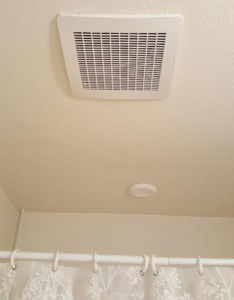 Most people don’t think too much about their bath fans other than to turn them on when they shower. For some, bath fans can be a source of frustration. They are often very loud and some opt not to use them so they can bathe in peace. And more often than not, they do not exhaust the water vapor from the shower effectively and we are left with a mirror dripping with condensation. We will be discussing several items regarding bath fans. These will be the job of the bath fan, things to keep in mind when considering a new bath fan, and typical bath fan installation.
Most people don’t think too much about their bath fans other than to turn them on when they shower. For some, bath fans can be a source of frustration. They are often very loud and some opt not to use them so they can bathe in peace. And more often than not, they do not exhaust the water vapor from the shower effectively and we are left with a mirror dripping with condensation. We will be discussing several items regarding bath fans. These will be the job of the bath fan, things to keep in mind when considering a new bath fan, and typical bath fan installation.
Why use a Bath Fan?
The job of a bath fan is much broader than just keeping the mirror from fogging up. Keeping your bathroom humidity at an acceptable level is important for many other reasons. The first reason would be to protect your metal fixtures. Most interior metal fixtures are not designed to be exposed to a lot of moisture and will corrode or rust prematurely. The second reason would be to protect painted surfaces. A good painter will always choose a higher quality paint in a higher sheen for the bathroom spaces because these paints will hold up better in these areas. However, interior paint is still not designed to be exposed to direct moisture and can be damaged if moisture is not kept to a minimum. The last reason is the big scary one – mold, mildew, and bacteria growth. These three grow best in warm, moist areas and the growth of these is not always obvious. Sometimes mold will grow behind a toilet or under a sink where it is not easily seen.
Which Bathroom Fan should I use?
Deciding which fan to install in your bathroom is not as simple as it used to be. Many retailers still live in the stone age and only highlight three to four features. These features are air exhaust rate, noise level, lighting, and style. The most common feature regarding bath fans is the level of air output. This is measured in CFM, or cubic feet per minute. The standard for figuring the size of fan you need is 1 CFM for every square foot of bathroom space. The second most common characteristic of bath fans is noise level measured in sones. Price and personal noise tolerance are the biggest determining factors here. Some people don’t mind the noise, some do. If the noise is bothersome, keep in mind that fans typically go up in price as the noise goes down. Less than one sone is considered a very quiet fan, while four or more sones is considered quite noisy. Fans can be equipped with their own light. These models are convenient if more light is needed closer to the shower or tub. You can have your choice of compact fluorescent, or LED for most models but be prepared to pay more for LED. The fan and light can be switched independently or together and some models even offer a night light that can be switched independently of both the main light and fan. Lastly, fans can come in different styles in case a plastic grate on the ceiling is too commercial for one’s taste. Keep in mind that you may lose more important features trying to find a more visually appealing fan.
More Bath Fan Features
If you happen to find yourself in an electrical or HVAC (heating, ventilation, and air conditioning) supply store shopping for bath fans you will have stepped out of the stone ages and will find even more fans features. Some of these include: motion sensors, heaters, humidity sensors, and improved energy efficiency. Not much needs to be said about improved energy efficiency – because let’s be honest – who wouldn’t like to save some money on their electric bill? As far as heaters go – they are much nicer than the heat lamps of old. Now when it comes to features that really separate truly functional bath fans from your standard room ventilator – the top two would be motion detectors and humidity sensors. As we trade in house rattling fans for whisper quiet models it is important that we take steps to make sure the fans don’t end up running 24/7. It is also important to make sure that the fans are being used when they are needed. These two features are the answers to both those issues. Motion sensors can help keep a fan on to exhaust moisture but may turn off prematurely if a person exits the bathroom before the humidity reaches an acceptable level. Powder baths are usually more appropriate places for fans with motion sensors due to the fact that they are primarily ventilating the area to prevent odors from building up. Humidity sensors are by far the best feature to have in a bath fan in full bathrooms. They run only when needed and shut off the minute the humidity reaches an acceptable level. We only install two-speed, humidity sensing, energy efficient fans at a cost of well under $100.
Bath Fan Installation
Lastly, we come to fan installation. This is probably as crucial as the fan choice itself. Improper fan installation can decrease the fans ability to exhaust, cause mold growth in your attic or eaves, and even cause moisture to drip from the fan. The biggest problem we see is with the ducting attached to the fan. Many builders cut corners and run the fan duct to the nearest roof vent. In some cases the nearest roof vent is 10, 15, or even 20 feet away. The more duct that is attached to your fan, the harder that fan has to work to exhaust the air. This can significantly slow your fan down and shorten its life. Often an installer will get the duct close to the roof vent, but not actually run it all the way up the vent. This can cause some, if not all of the moist air to exhaust into your attic space creating a perfect environment for mold. More often than not the duct is not insulated. In the colder months of the years this can cause the moisture to condense inside the duct and drain back toward the fan. There is nothing worse than to have a nice hot shower ruined by icy cold water dripping on you from your fan! Yet another mistake installers make is to run corrugated duct to speed up installation. Corrugated duct can cause turbulence as the air moves through it which also decreases the efficiency of the fan. Many installers don’t even mount the fan where it will do the most good. The largest source of moisture in the bathroom will always be the shower, and thus the fan should be mounted as close to the shower as possible. The further the fan is from the shower, the more opportunity the moisture has to condense on your fixtures and paint before it is exhausted to the outside. To do the best good a fan must exhaust the moist air before the moisture has a chance to condense on anything. The last and increasing more common mistake we see is fan ducting that exhausts to the eves of a home. This type of installation can be spotted from the outside of the home because there is often one distinct portion of the eve that will have abnormal mold and mildew growth. In extreme cases the paint will even be peeling. In addition to exterior paint damage there is also the issue of efficiency. Soffit or eve venting forces the warm, moist, air to move laterally which is not nearly as efficient as moving the air vertically. Vertical exhausting takes advantage of the fact that the air is already rising on its own.
To sum up, our fan installations include the following:
- Energy efficient, humidity sensing, super quiet fans appropriate for the size of the bathroom.
- Fans located as close to the shower and/or tub as possible.
- Fans attached to a short, vertical, insulated run of ridged duct with its own dedicated roof vent.
Call to see if your fan needs to be updated today, don’t wait until you have moisture issues!

Leave A Comment